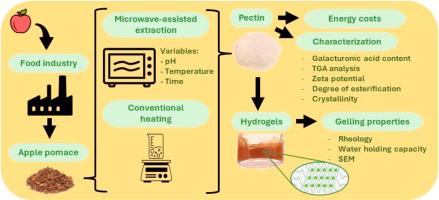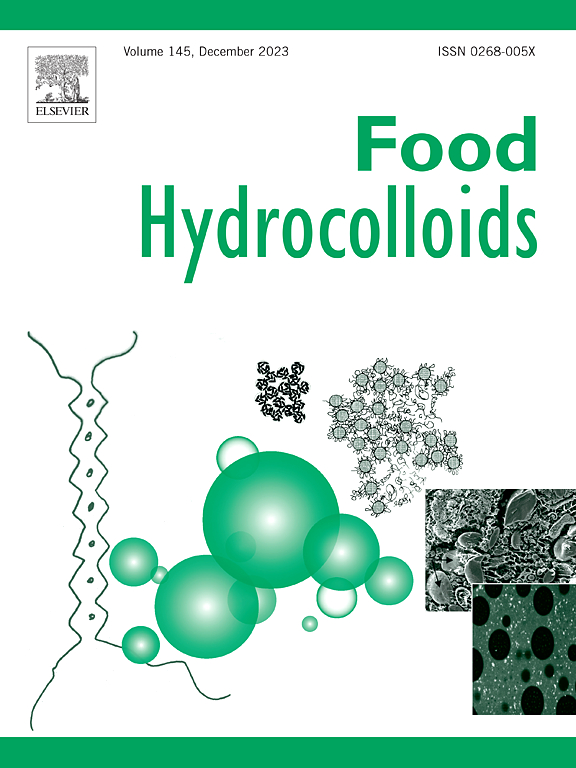微波对从苹果渣中提取果胶的影响:水凝胶结构的技术特性
IF 11
1区 农林科学
Q1 CHEMISTRY, APPLIED
引用次数: 0
摘要
副产品的价值化消除了经济障碍的风险,减少了产品的总体污染量和碳足迹。在这种情况下,比较了传统加热萃取(CE)和微波辅助萃取(MAE)从苹果渣中提取果胶的方法。根据后续果胶水凝胶的特性,评估了温度对 MAE 的影响。MAE 萃取 5 分钟后果胶产量为 10.6 ± 0.3%,而 CE 萃取 2 小时后果胶产量为 9.5 ± 0.3%。大多数样品的半乳糖醛酸含量大于 60%。Zeta 电位分析表明果胶能够形成稳定的凝胶。根据 X 射线衍射图,提高提取温度会导致果胶结构的结晶度降低。流变学测试表明,果胶基水凝胶的存储模量随着 MAE 温度从 80°C 增加到 100°C 而增加。所有水凝胶的持水能力都大于 50%。此外,对电能消耗和能源成本的分析凸显了使用微波加热技术提取果胶的经济优势。本文章由计算机程序翻译,如有差异,请以英文原文为准。

Impacts of microwaves on the pectin extraction from apple pomace: Technological properties in structuring of hydrogels
The valorization of by-products eliminates the risks of economic barriers and reduces the overall amount of pollution and the carbon footprint of the products. In this context, conventional heating extraction (CE) and microwave-assisted extraction (MAE) were compared to extract pectin from apple pomace. The effects of temperature on MAE were evaluated based on the resulting properties obtained in subsequent pectin hydrogels. A pectin yield of 10.6 ± 0.3% was obtained by MAE with 5 min extraction, while CE showed a yield of 9.5 ± 0.3% after 2 h. The pectin extracted by both methods had a low methoxyl content, indicating a low degree of esterification. The galacturonic acid content was greater than 60% for most samples. Zeta potential analysis indicated the ability of the pectin to form stable gels. According to the X-ray diffractograms, increasing the extraction temperature led to a decrease in the crystallinity of the pectin structure. Rheological tests showed increased storage modulus as the temperature increased by MAE from 80 to 100 °C for the pectin-based hydrogel. The water holding capacity was greater than 50% for all hydrogels. Furthermore, an analysis of electrical consumption and energy costs highlighted the economic advantage of using microwave heating technology to extract pectin.
求助全文
通过发布文献求助,成功后即可免费获取论文全文。
去求助
来源期刊

Food Hydrocolloids
工程技术-食品科技
CiteScore
19.90
自引率
14.00%
发文量
871
审稿时长
37 days
期刊介绍:
Food Hydrocolloids publishes original and innovative research focused on the characterization, functional properties, and applications of hydrocolloid materials used in food products. These hydrocolloids, defined as polysaccharides and proteins of commercial importance, are added to control aspects such as texture, stability, rheology, and sensory properties. The research's primary emphasis should be on the hydrocolloids themselves, with thorough descriptions of their source, nature, and physicochemical characteristics. Manuscripts are expected to clearly outline specific aims and objectives, include a fundamental discussion of research findings at the molecular level, and address the significance of the results. Studies on hydrocolloids in complex formulations should concentrate on their overall properties and mechanisms of action, while simple formulation development studies may not be considered for publication.
The main areas of interest are:
-Chemical and physicochemical characterisation
Thermal properties including glass transitions and conformational changes-
Rheological properties including viscosity, viscoelastic properties and gelation behaviour-
The influence on organoleptic properties-
Interfacial properties including stabilisation of dispersions, emulsions and foams-
Film forming properties with application to edible films and active packaging-
Encapsulation and controlled release of active compounds-
The influence on health including their role as dietary fibre-
Manipulation of hydrocolloid structure and functionality through chemical, biochemical and physical processes-
New hydrocolloids and hydrocolloid sources of commercial potential.
The Journal also publishes Review articles that provide an overview of the latest developments in topics of specific interest to researchers in this field of activity.
 求助内容:
求助内容: 应助结果提醒方式:
应助结果提醒方式:


